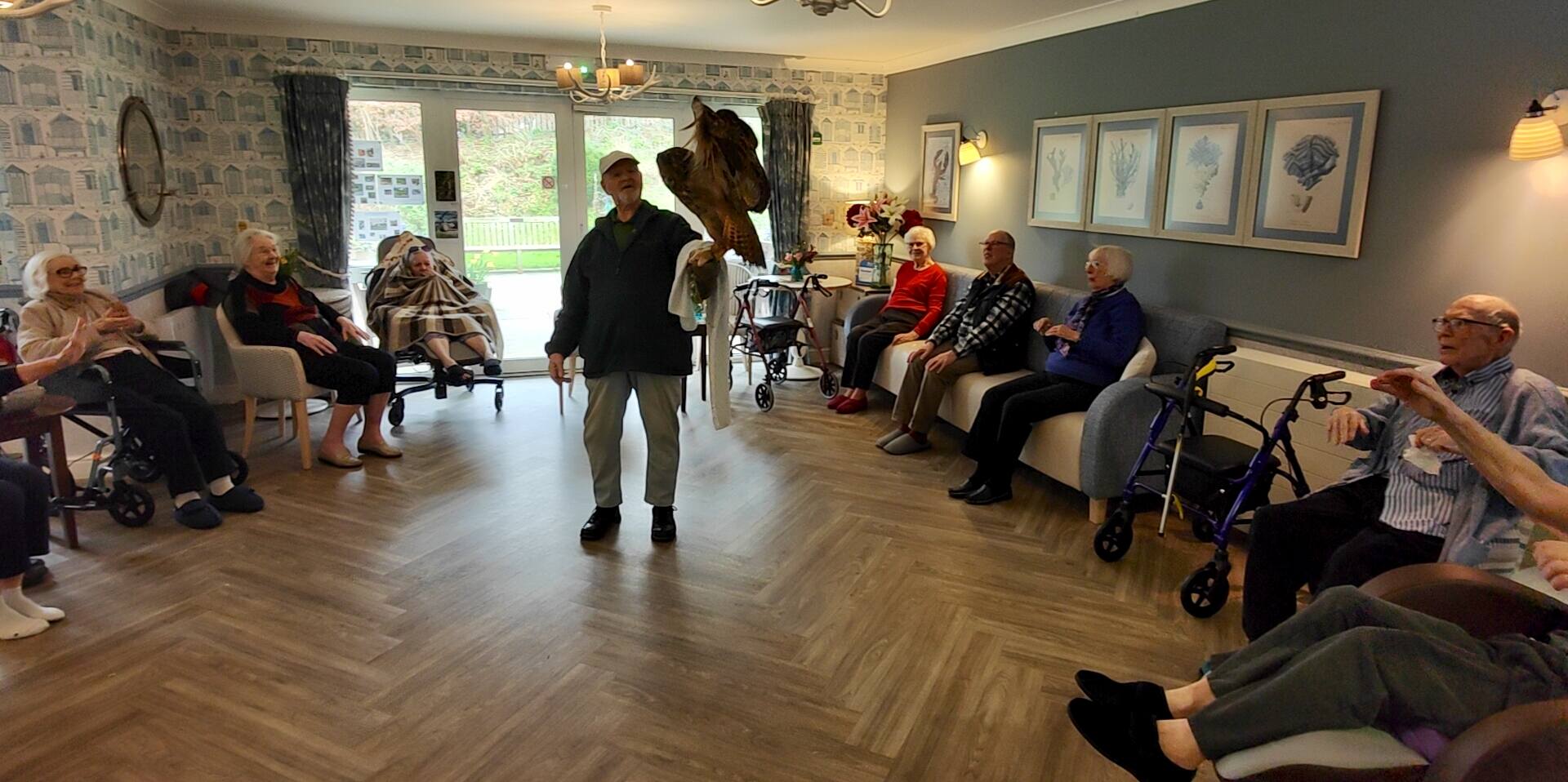How a Dementia Friendly Environment Can Enhance Well-Being

Creating a dementia-friendly environment is crucial for enhancing the well-being of individuals living with dementia. A well-designed, supportive environment can help reduce confusion, promote independence, and improve the overall quality of life for dementia patients. From lighting choices to clear signage and interactive technologies, every aspect of the built environment plays a role in ensuring that people with dementia feel safe, comfortable, and engaged.
The Importance of a Dementia-Friendly Environment
For individuals living with dementia, navigating everyday spaces can be challenging due to memory loss, disorientation, and cognitive decline. A dementia-friendly environment can reduce confusion and anxiety while promoting safety and independence. Best practice in dementia care environments includes features such as natural light, contrasting colours, clear signage, and adequate lighting to support individuals with unique needs.
Family members, caregivers, and care homes must prioritise creating spaces that foster a sense of security and familiarity. By incorporating dementia-friendly design principles, care environments can make a big impact on the lives of older people, helping them maintain a sense of identity and independence.
Key Elements of a Dementia-Friendly Environment
1. Adequate Lighting and Natural Light
Proper lighting is essential in dementia-friendly environments. Well-lit spaces help prevent falls, reduce confusion, and create a calming environment. Natural light is particularly beneficial for individuals living with dementia, as it helps regulate circadian rhythms, improving sleep patterns and overall well-being. Care homes should incorporate large windows, skylights, and strategically placed lighting to ensure spaces are bright and welcoming.
2. Clear Signage and Contrasting Colours
Navigating care environments can be difficult for people with dementia. Clear signage with large, readable fonts and simple symbols can help individuals find their way. Using contrasting colours between walls, doors, and flooring enhances visibility and prevents accidents. For example, brightly coloured toilet seats and clearly marked bathroom doors can enable people to locate essential facilities easily, promoting dignity and independence.
3. Safe and Accessible Spaces
A well-designed built environment should prioritise safety by incorporating grab rails, non-slip flooring, and well-defined walking paths. Care environments should be free of unnecessary obstacles that could cause confusion or injury. Preventing accidents through thoughtful design can significantly enhance the quality of life for dementia patients.

4. Calming and Engaging Outside Spaces
Outdoor areas are essential in dementia-friendly environments, offering opportunities for physical activity, relaxation, and social interaction. Gardens, walking paths, and seating areas provide a safe space where individuals can connect with nature, which has been shown to reduce anxiety and enhance well-being.
5. Interactive Technologies and Daily Activities
Interactive technologies can play a vital role in dementia care by providing cognitive stimulation, social engagement, and emotional comfort. Digital touchscreens, virtual reality experiences, and reminiscence therapy tools can help people with dementia stay connected with their memories and engage in meaningful daily activities. These technologies can also support caregivers by offering structured activities tailored to the individual’s needs.
6. Familiar and Homely Environments
Creating a homely atmosphere is crucial in dementia care. Using furniture and decor that resemble a familiar home setting can ease anxiety and provide a sense of comfort. Personalised spaces with family photos, favourite objects, and familiar scents can reinforce a connection to the past and reduce distress.
7. Sensory Stimulation for Well-Being
Sensory stimulation through sound, touch, and smell can help dementia patients engage with their surroundings. Music therapy, textured walls, and scented gardens can evoke positive memories and contribute to emotional well-being. Simple activities such as handling familiar objects or listening to calming music can make a significant impact.
8. Encouraging Social Interaction
Social engagement is a key component of dementia-friendly environments. Communal areas, group activities, and shared dining experiences foster connections among residents, reducing feelings of loneliness and isolation. Creating opportunities for structured and spontaneous interactions can enhance emotional and psychological health.
9. Training for Caregivers and Staff
Providing ongoing dementia awareness training for caregivers and staff ensures that they can effectively support people living with dementia. Training programs should focus on understanding symptoms, responding to behaviours with compassion, and implementing best practices in dementia care.
10. Access to Emergency Services and Support Networks
Ensuring that emergency services and support networks are easily accessible is critical for dementia-friendly environments. Clear emergency procedures, well-marked exits, and staff trained in crisis management contribute to the safety and security of dementia patients.
11. Reducing Anxiety Through Routine and Structure
Establishing a consistent daily routine can be incredibly beneficial for dementia patients, as predictability helps reduce anxiety and confusion. Familiar schedules for meals, activities, and rest can create a sense of stability and security. Structured activities such as gentle exercise, arts and crafts, or reminiscence therapy allow individuals to engage meaningfully while maintaining a routine that fosters well-being.
12. Incorporating Multi-Sensory Environments
Multi-sensory environments (MSEs) use lights, sounds, and tactile experiences to provide soothing stimulation for dementia patients. These spaces can help improve focus, reduce agitation, and promote relaxation. Interactive elements like fibre-optic lights, bubble tubes, and aromatherapy can enhance cognitive engagement and emotional comfort.
13. The Role of Colour Psychology in Dementia Care
Colour choices can significantly impact how dementia patients navigate their environment. Warm, soft tones can create a welcoming atmosphere, while strong contrasts help define different spaces. For example, using blue or green in relaxation areas promotes calmness, whereas vibrant colours can highlight important features such as handrails or doors.
14. Promoting Independence Through Thoughtful Design
A well-planned dementia-friendly environment supports independence by allowing individuals to carry out daily tasks with minimal assistance. Features such as open shelving, easy-to-use kitchen appliances, and well-marked pathways can help dementia patients maintain their autonomy for as long as possible.
15. Supporting Family Members in Dementia Care
Family members play a vital role in the care journey of dementia patients. Providing spaces within care homes where families can visit, reminisce, and interact with their loved ones in a comfortable setting fosters emotional well-being. Additionally, offering educational resources and support groups for family caregivers can help them navigate the challenges of supporting someone with dementia.

16. Collaboration with Local Communities and Charities
Dementia-friendly communities extend beyond care homes. Collaborating with local organisations, businesses, and charities such as the Alzheimer's Society ensures that people with dementia remain connected to the wider world. Initiatives such as dementia-friendly cafes, walking groups, and memory clinics help create inclusive spaces that allow individuals to participate in daily life.
The Role of Destination Points in Dementia Care
Destination points within care environments serve as landmarks that provide individuals with a sense of purpose and direction. These can include themed rooms, sensory gardens, activity stations, or café-style seating areas. Having designated destination points within a dementia-friendly environment helps reduce confusion, encourage movement, and promote independence.
For example, a themed reminiscence room designed to resemble a 1950s living space can evoke comforting memories and stimulate conversation among residents. Similarly, an interactive music station can enable people to engage with familiar songs, improving mood and cognitive function.
The Fleet Care Home: A Leading Example of a Dementia-Friendly Community
At The Fleet Care Home, we understand the importance of creating a dementia-friendly environment that enhances well-being. Our newly developed dementia community is designed with best practice principles in mind, incorporating destination points, interactive technologies, and a supportive environment tailored to the unique needs of individuals living with dementia.
Our state-of-the-art facility features:
- Destination Points: Carefully curated spaces that encourage movement, engagement, and social interaction.
- Interactive Technologies: Innovative tools designed to stimulate cognitive function, provide comfort, and support daily activities.
- Natural Light and Adequate Lighting: Ensuring all spaces are well-lit to promote safety and prevent falls.
- Clear Signage and Dementia-Friendly Design: Enhancing wayfinding and reducing confusion through thoughtful layout and design choices.
- Outside Spaces for Well-Being: Beautifully landscaped gardens that offer a calming environment for relaxation and physical activity.
- Sensory and Reminiscence Therapy: Spaces designed to engage residents through music, touch, and scent, improving emotional well-being.
- Social and Community Integration: Activities that involve family members and the wider community, fostering a sense of belonging.
Our commitment to dementia awareness and high-quality dementia care is reflected in every aspect of our environment. By prioritising safety, comfort, and engagement, we aim to enable people living with dementia to maintain their independence, dignity, and sense of self.
Creating a dementia-friendly environment is essential for enhancing the well-being of individuals living with dementia. By incorporating clear signage, natural light, contrasting colours, interactive technologies, and thoughtfully designed destination points, care environments can reduce confusion, promote independence, and improve quality of life.
The Fleet Care Home's new dementia community is a shining example of how best practice in dementia-friendly design can make a real difference. By embracing innovative solutions and a person-centred approach, we ensure that our residents receive the highest quality of care in a safe, engaging, and supportive environment.
For more information on our dementia care services and how we create a nurturing environment for individuals affected by Alzheimer’s disease and other forms of dementia, please contact The Fleet Care Home today.






